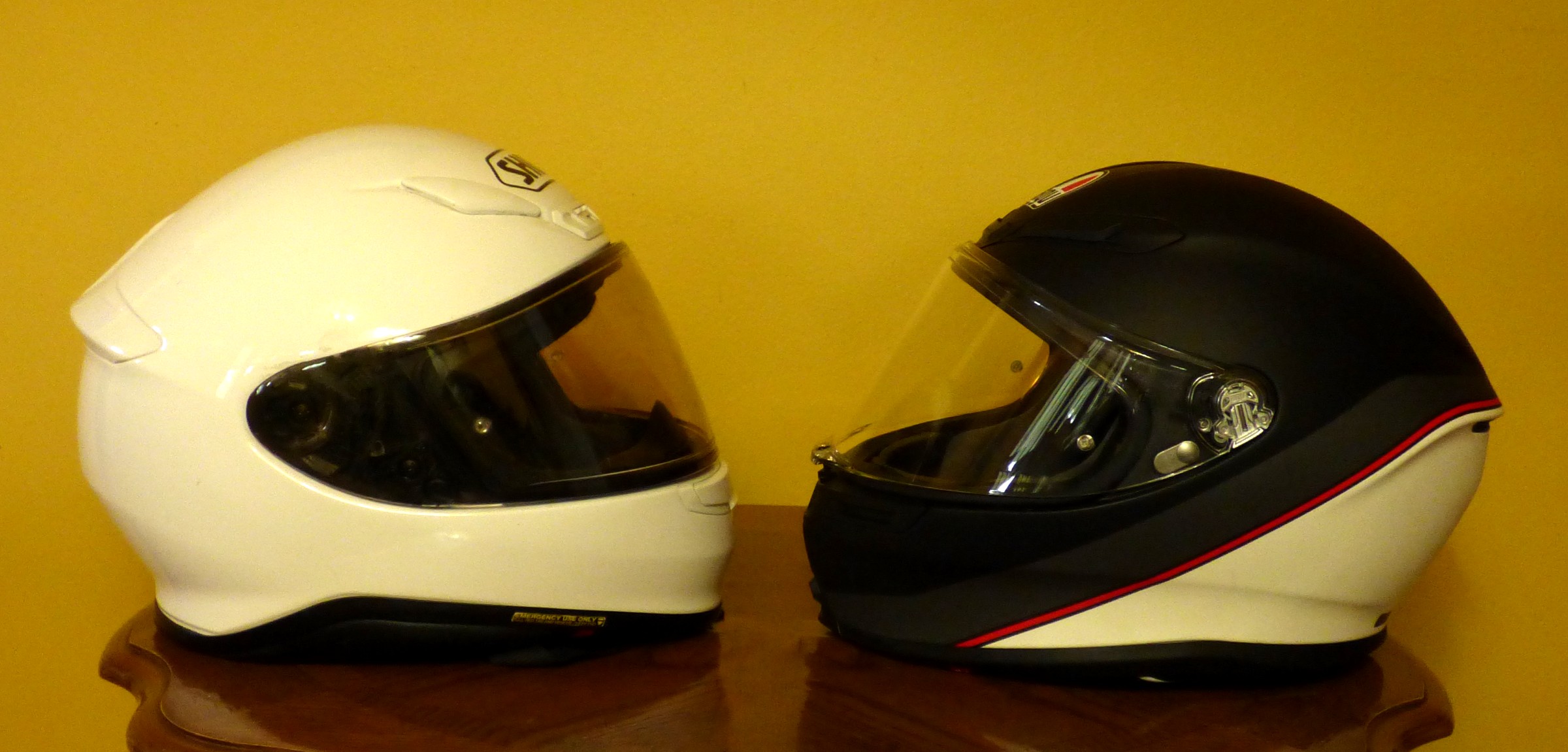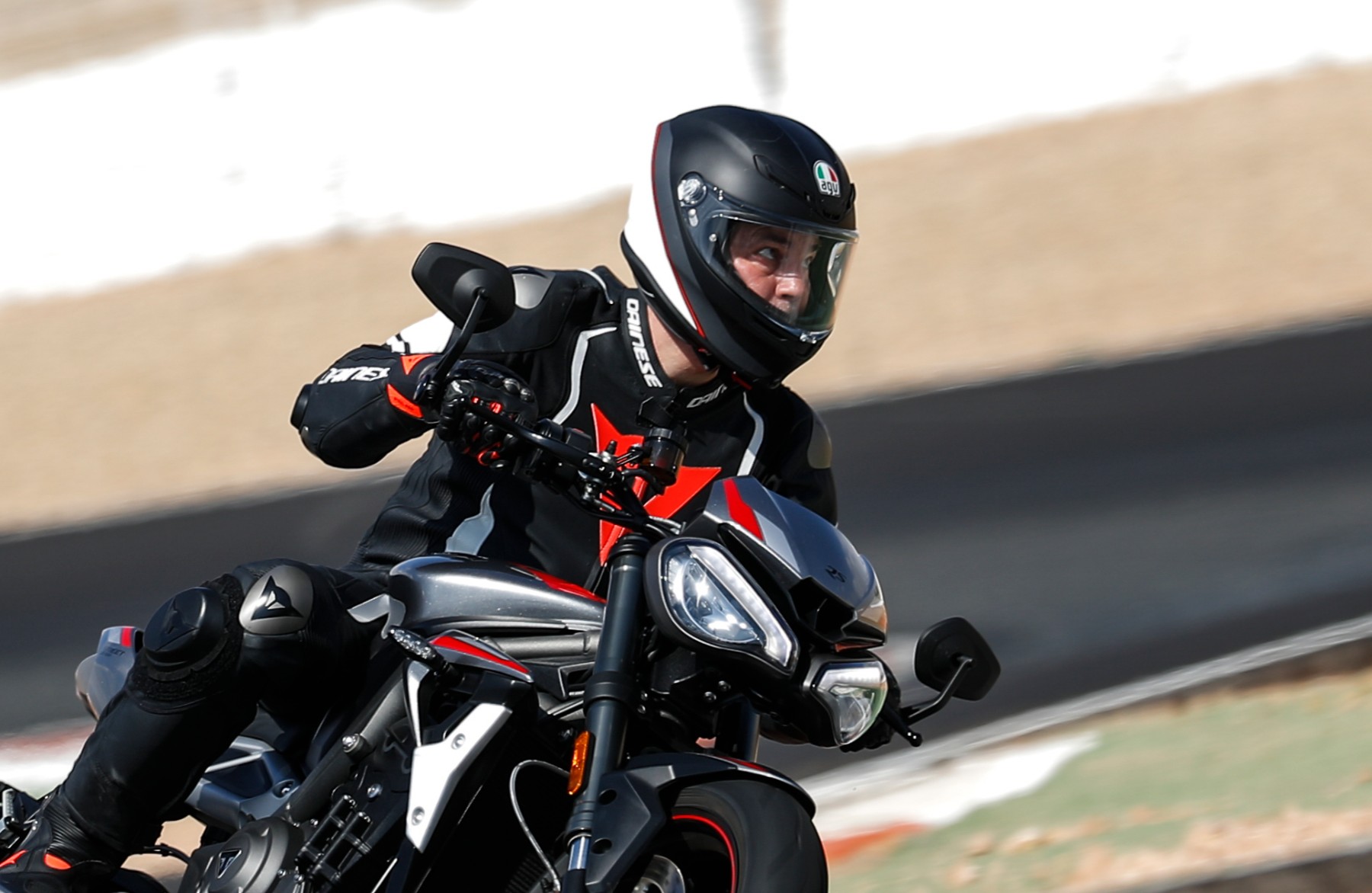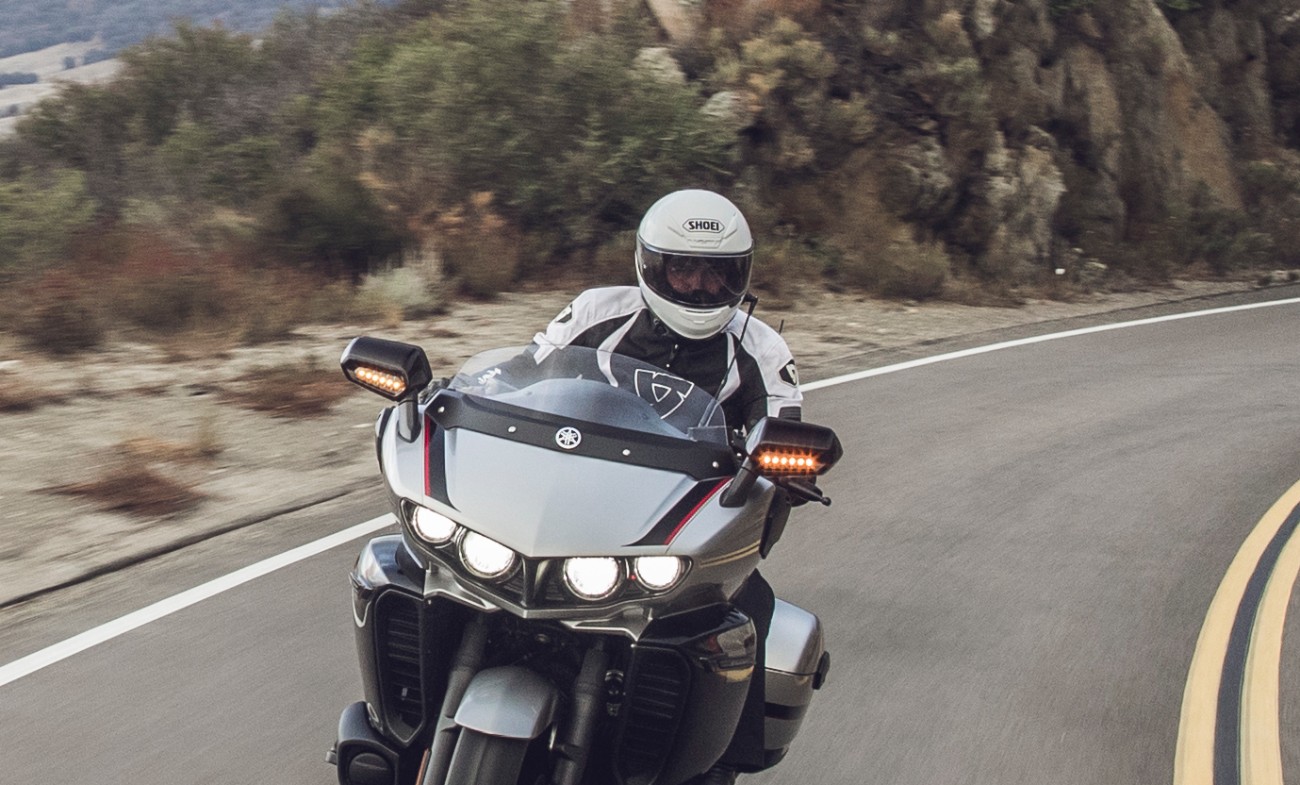For several years, the Shoei RF-1200 has been my go-to helmet and I’m not alone. It’s nowhere near the least expensive but nor is it the most costly or the epitome of the latest technology. It’s simply a premium full-face helmet that demonstrates quality, provides ample comfort, offers some interesting features and fits a lot of people.
Meanwhile, the AGV K6 came out last year and was a bit of a departure for that company. Coming in around the $500 level, like the Shoei, it offered a slightly different mix of attributes and immediately started winning fans. So is the AGV a candidate to become my new standby, a reliable replacement for the Shoei RF-1200? Is lightweight Italian flair about to unseat solid Japanese design as the new yardstick for measuring quality, full-face motorcycle helmets for street use? I tested and compared the two side by side to find out.

The Shoei RF-1200 (left) has DOT and Snell certification and retails at RevZilla starting at $485.99 for solid colors and more for graphics. The AGV K6 (right, shown in the Minimal graphic) starts at $499.95 for solids and has DOT and ECE certification.
AGV K6 features
The first thing anyone will notice about the K6 is how light it is, thanks to the carbon-aramid shell. The medium-small size I wear weighs just two pounds, 14 ounces. Light does not mean unsubstantial, however, as it has an ECE rating as well as DOT (but not Snell).
The K6 is not only light, but also trim in size. AGV makes four different shell sizes. For those riders who don’t want to look like a bobble-head doll, that’s an issue. Instead of using the same large shell and filling it with different sizes of liners and padding to make it fit, the smaller sizes of the K6 are externally smaller. It’s not something that I think about (I rarely look at myself in the mirror when wearing a helmet), but I know it matters to some riders.
The K6 has five vents for ventilation on hot days, though they are relatively small: three brow vents, opened with three different sliding tabs, and two chin vents operated with one tab. There’s a passive vent in the rear to let warm air exit.
The liner can be removed and washed and feels comfortable against the skin. Like the rest of the helmet, it suggests quality, as it should at this price point.
The faceshield mechanism on the K6 is simple and easy to use. It’s also small, which contributes to the light weight, but despite the compact size it appears fairly strong, as the parts are made of metal instead of plastic. The clear faceshield that comes with the helmet is Pinlock-ready and a Pinlock insert is included, so without any additional cost you’re ready for cool or damp days with the best anti-fogging solution.

I first used the AGV K6 last year when I test-rode the 2020 Triumph Street Triple RS, a day of riding that involved both street and track. Photo by Kingdom Creative.
Two other faceshield features should be noted. First, when fully closed, the shield locks into the closed position. To open it, you have to push a button in the center, just below the tab on the shield itself, to release the lock so you can crack it open at a stop. It’s a move that can easily be done with one finger — press and lift — but only after some practice.
Second, the AGV K6 has a wider eyeport than any other full-face helmet I’ve worn. If you’re the kind of rider who feels claustrophobic in a full-face helmet or if you feel it is impinging on your peripheral vision, then the K6 is your best bet for feeling comfortable.
While many AGV helmets are aimed at racing or track-day use, the K6 is built more for street riding and the U.S. market. The former is seen in its less prominent spoiler on the back and smoother overall shape. Evidence of the latter is its intermediate oval shape, which is the most common fitment in North America. Both those traits also position it directly against the helmet that is basically my measuring stick for street helmets: the Shoei RF-1200
Shoei RF-1200 features
The Shoei RF-1200 came out in 2013 as a successor to the RF-1100 and had a noticeably more compact shell, as the K6 does.
While not as light as the K6, the RF-1200 is by no means a heavy helmet. I wear a medium in the Shoei and it weighs three pounds, eight ounces. The RF-1200 is available in 10 different solid colors, as well as a variety of graphics.
The RF-1200 also comes with a Pinlock-ready faceshield but you’ll have to buy your own insert. The mechanism for changing the faceshield is easy to use, though maybe it falls just a bit short of the AGV’s system because some parts are plastic. But Shoei offers a feature AGV doesn’t have: an optional Transitions photochromic faceshield. I have one on the white RF-1200 shown in the photos here and I love it, though I’ve also warned about the fact that they don’t last forever (and they’re expensive). The beauty of the photochromic shield is that it makes the faceshield changing system almost irrelevant because I almost never have to change it all summer. The only time I need to swap it is when I want to use the clear shield with the Pinlock insert in conditions prone to fogging.
The action of the faceshield on the Shoei is maybe a bit less precise, and the tab used to raise the shield is located off-center to the left. That makes sense, since a rider is going to use his or her left hand to crack open the shield while riding, but it means that lifting on the tab creates some torsional force that makes the shield movement less smooth than the AGV’s, with the tab in the center.

I have been riding with the Shoei RF-1200 for several years and have used it on a wide variety of motorcycles. Here, I’m all wired up on the Yamaha Eluder touring bagger. Photo by Drew Ruiz.
The shapes of these two helmets are strikingly similar, with a smooth, gimmick-free shell with an understated spoiler on the rear and basically the same array of vents. Both are also classic intermediate oval in terms of fit.
It seems obvious AGV took direct aim at the RF-1200 when they produced the K6. So how do they compare in real-world use? In addition to riding with both helmets over the past few months, I also compared them back to back in a test ride.
AGV K6 versus Shoei RF-1200 test ride
As mentioned before, I’ve had my RF-1200 (two of them actually) for a few years. RevZilla assigned me the K6 last fall when I went to the press intro for the Triumph Street Triple RS, which involved both street and track riding. So I’ve had the K6 for several months. As a result, I already had well formed impressions of both.
The main purpose of my test ride was to compare the quietness of the two helmets. Noise levels are terribly difficult to quantify in a helmet review because there are so many variables. In this case, I was able to ride the same route on the same bike (my naked Triumph Speed Triple) with the same earplugs (I always wear earplugs) to try to compare the noise levels and any other comfort differences.
Honestly, I expected the Shoei to be a little quieter. I think we’re conditioned to think that a lighter product is more flimsy and, in the case of a helmet, will be noisier. In reality, in my back-to-back test ride, I couldn’t detect any significant difference between the two helmets in overall noise level. Maybe there was a qualitative difference. It seemed the AGV attenuated the bass more and the Shoei dampened the treble more, but I can’t really say one has a big advantage over the other.
I’m sensitive to noise. It tires me on long rides (and I routinely do 500-mile days) and I already have some mild hearing impairment from decades of riding so I always wear earplugs. If one of these two helmets had a clear advantage over the other in terms of noise level, you can bet that would make it my favored choice. In the end, I decided I couldn’t determine a clear winner.
Both helmets are comfortable and feel like quality pieces, but wearing them back to back also was instructive. The Shoei feels just a shade more plush and, despite the fact that I expected the MS AGV to feel more snug than the M Shoei, the thicker padding in the Shoei made it feel like it was coddling my head and cheeks more tightly. Though not uncomfortably so.
Ventilation is not a strong point for either. The brow vents are nearly identical. But I give a very slight nod to the Shoei because the chin vent flows some air upward across the face in a way that can be cooling on a hot day, while the chin vent on the AGV is not particularly effective.
Conclusion: Which do you choose?
It sure looks like AGV used the Shoei RF-1200 as a clear target when it developed the K6. These two helmets are very similar in shape, purpose, fit, function and price. They’re also very similar in their end performances.
So if you’re looking for a premium intermediate-oval helmet for street use, how do you choose? By deciding which features are most important to you.
If you care a lot about light weight, the AGV K6 is the clear choice.
If you want the option of a photochromic faceshield, the Shoei RF-1200 is the obvious choice. If you are happy carrying both a clear and smoked faceshield and swapping them, the AGV is probably better for its slick shield-change mechanism.
If you want plush feel and comfort, lean toward the Shoei. But I’d advise trying on both of them first, because a fit that some will describe as reassuringly snug and plush will feel too tight and annoying to others, depending on personal preference.
Honestly, the two helmets are so close that if you chose based on which one offered a color or graphic you wanted, I wouldn’t blame you. I’m sure AGV set out to topple the Shoei RF-1200, but what they really did is provide a worthy alternative, and that’s not a shortcoming.
Personally, I will probably still reach for my Shoei RF-1200 more often than the AGV K6, But it’s great to have such good choices.



If an intermediate oval works, you have a few other choices in the premium helmet space. I noticed that Arai and Shark weren’t included in your consideration. I wear a long oval, intermediate ovals and round helmets force me to size up to avoid hot spots. I hope that a shrinking market doesn’t move every helmet maker to a single profile for helmets. Otherwise, minority head shapes at the two ends of the spectrum will need to buy a compromise helmet.
I don’t have any experience with Shark helmets. Shoei and Arai are the two usually compared, and my colleague at RevZilla, Spurgeon, wrote an excellent article that really explains the philosophical difference between the two brands. I’ve been a Shoei kind of guy, myself, though the Arai fans are really passionate about their preference. I compared the AGV here because it’s new and because it’s so very similar to the Shoei RF-1200 (and because it’s what was provided to me for the Street Triple test ride).
I don’t think the large helmet manufacturers are going to migrate to one profile because they already make various shapes to fit the biggest number of people in markets around the world.
Good comparison. This is the year I decided I was finally going to buy a quality helmet and the Shoei was at the top of the list but when I tried on the AGV I was sold. The weight difference is incredible. I like to go on long rides and not having an extra pound of weight on my head really makes a difference.